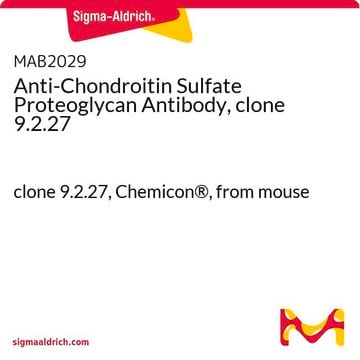AB5320B
Anti-NG2 Chondroitin Sulfate Proteoglycan, Biotin Conjugate Antibody
from rabbit, biotin conjugate
Synonim(y):
Chondroitin sulfate proteoglycan 4, Chondroitin sulfate proteoglycan NG2, Melanoma chondroitin sulfate proteoglycan, Melanoma-associated chondroitin sulfate proteoglycan
About This Item
Polecane produkty
pochodzenie biologiczne
rabbit
Poziom jakości
białko sprzężone
biotin conjugate
forma przeciwciała
purified antibody
rodzaj przeciwciała
primary antibodies
klon
polyclonal
reaktywność gatunkowa
rat
reaktywność gatunkowa (przewidywana na podstawie homologii)
mouse (based on 100% sequence homology), monkey (based on 100% sequence homology), human (based on 100% sequence homology)
metody
immunocytochemistry: suitable
immunohistochemistry: suitable
numer dostępu NCBI
numer dostępu UniProt
Warunki transportu
wet ice
docelowa modyfikacja potranslacyjna
unmodified
informacje o genach
human ... CSPG4(1464)
mouse ... Cspg4(121021)
rat ... Cspg4(81651)
rhesus monkey ... Cspg4(713086)
Opis ogólny
Zastosowanie
Immunocytochemistry Analysis: A 1:100 dilution from a representative lot detected NG2 in rat oligodendrocyte precursor cells. Performed without Triton.
Jakość
Immunohistochemistry Analysis: A 1:100 dilution of this antibody detected NG2 in cryosections of rat cortex tissue.
Opis wartości docelowych
Komentarz do analizy
Cryosections of rat cortex tissue
Not finding the right product?
Try our Narzędzie selektora produktów.
Kod klasy składowania
10 - Combustible liquids
Klasa zagrożenia wodnego (WGK)
WGK 2
Temperatura zapłonu (°F)
Not applicable
Temperatura zapłonu (°C)
Not applicable
Certyfikaty analizy (CoA)
Poszukaj Certyfikaty analizy (CoA), wpisując numer partii/serii produktów. Numery serii i partii można znaleźć na etykiecie produktu po słowach „seria” lub „partia”.
Masz już ten produkt?
Dokumenty związane z niedawno zakupionymi produktami zostały zamieszczone w Bibliotece dokumentów.
Nasz zespół naukowców ma doświadczenie we wszystkich obszarach badań, w tym w naukach przyrodniczych, materiałoznawstwie, syntezie chemicznej, chromatografii, analityce i wielu innych dziedzinach.
Skontaktuj się z zespołem ds. pomocy technicznej








